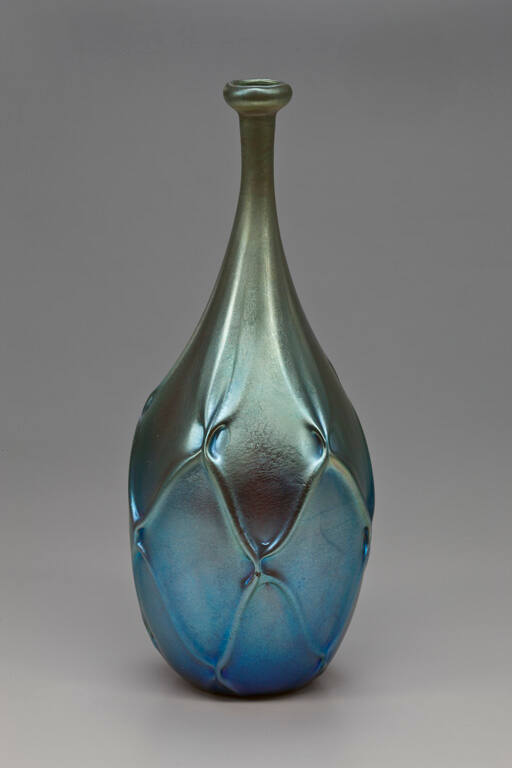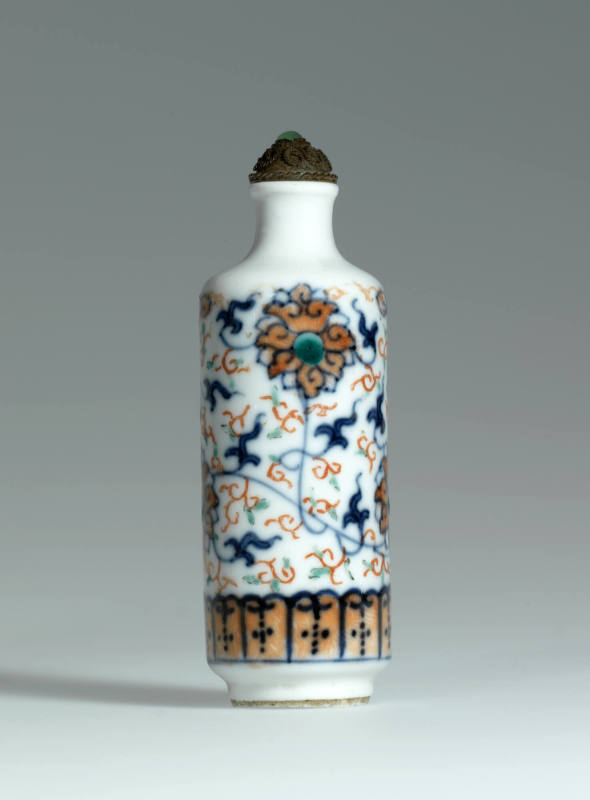
Object Details
Artist
Louis Comfort Tiffany
Date
ca. 1905
Medium
Glass
Dimensions
Height: 9 1/2 inches (24.1 cm)
Credit Line
Edythe de Lorenzi CollectionBequest of Otto de Lorenzi
Object
Number
64.0850
BRIEF DESCRIPTIONThis is a Tiffany light blue iridescent glass bottle with a slender neck and round (…)
BRIEF DESCRIPTIONThis is a Tiffany light blue iridescent glass bottle with a slender neck and round body. The sides have been pinched in a uniform pattern over the surface.WHERE WAS IT MADE?Tiffany glass was made at the Tiffany Glass Furnaces in Corona, located in Queens, New York.WHO WAS THE ARTIST?Louis Comfort Tiffany was the eldest son of Charles L. Tiffany, founder of Tiffany & Company, the New York jeweler. Tiffany was trained as a painter, studying with both George Inness and Samuel Coleman in New York and Leon Bailly in Paris. He eventually turned his attention to decorative arts and began experimenting with glass-making techniques in 1875. After success with stained glass windows and mosaics, Tiffany established the Tiffany Glass Company in 1885 and began devoting production to one-of-a-kind blown glass art objects. He soon became one of America’s most prolific designers, providing furniture, wallcoverings, textiles, jewelry and glass to some of society’s most important citizens.HOW WAS IT MADE?Like most Tiffany vases, this vase was created using a blowpipe. While the glass was still hot, the sides of the bottle were pinched to create the raised decoration.This bottle features metallic blue luster decoration upon the surface. Luster is a form of staining. This shiny effect comes from covering the surface of a vessel with metallic oxides that have been dissolved in acid and mixed with an oily medium. The vessel is then fired in a kiln at a temperature around 1150 degrees Fahrenheit, depositing a film upon the surface that, when cleaned, becomes shiny.WHY DOES IT LOOK LIKE THIS?This vase is an example of Tiffany’s Favrile glass. In 1894, Tiffany patented his iridescent glass under the name Favrile. The word Favrile is derived from the Old English fabrile, meaning hand-wrought. Tiffany design was inspired by glass from ancient Rome and the Islamic world, Venice and Bohemia. Tiffany combined his talent as a colorist, naturalist, and designer with his experimentations on blown glass surfaces. Vessels were fumed with metallic oxides to achieve iridescence. To see other examples of Tiffany’s Favrile glass in the Johnson Museum’s collection, search for object numbers 57.072, 57.080, 57.088, 57.097, 57.106, 64.0840, 64.0841, 64.0842, 64.0843, 64.0865, 64.0875, 64.0879, 64.0885, 64.0889, 64.0898, 64.0904, 99.078.118 a,b, and 2001.075.003 in the keyword search box.












